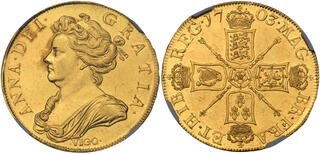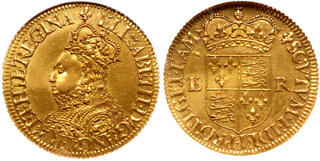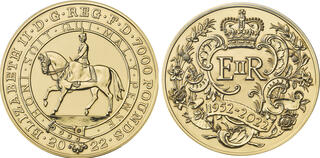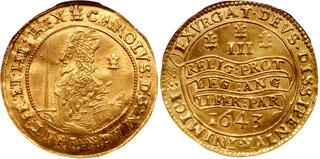Lot description:
Great Britain. "VIGO" Five Guineas, 1703. S-3561; Fr-183; KM-520.1. 41.69 grams. SECVNDO on edge. Queen Anne, 1702-1714. Draped bust left; VIGO below bust. Reverse; Crowned cruciform arms, with alternating scepters and a central (Tudor) rose. Uncirculated, a wonderful specimen blessed by superb eye appeal, with all details sharp, and complimented by deep, proof-like luster. Scattered faint hairlines (from being in important collector cabinets over the past 300 years). Historical, and excessively rare. Sure looks like a special proof strike. Pop 1; The Finest Proof-Like graded at any service. PCGS graded MS-61 Prooflike. Estimated Value $300,000 - UP
The queen is shown facing left with her long hair curled and tied in a bow, her body draped. Beneath her portrait are the letters VIGO in large capitals. The reverse shows the date at top and consists of the classic "cruciform" composed of the shields of the kingdoms (England, Scotland, France and Ireland), each with a crown over it, a double open rose at center, each angle displaying a scepter topped by an emblem of the four kingdoms-of England, Scotland, France and Ireland in order from the first to last angle. The bold surrounding legend in Latin abbreviations proclaims her Queen of Great Britain, France and Ireland.
For centuries, since the victory at Agincourt in 1415, English kings and queens claimed to be the sovereigns of France, and this appears in their titles as seen on this coin. Bourbon Spain and Catholic France were the oldest enemies of the kingdom. During the 17th and 18th centuries, English buccaneers attacked their ships at sea, attempting to seize treasure, especially gold and silver mined in the New World and being transported back to Spain for that country's coinage. One of the most famous of all seizures occurred near the beginning of Queen Anne's reign, in October 1702. England and the Dutch Republic were allies against their common enemies. Sir George Rooke of the British navy was in command of some 50 warships that attacked a treasure fleet returning from South America anchored at Vigo Bay on the northwest coast of Spain. It consisted of three Spanish treasure galleons protected by French warships. Rooke and his fleet of warships entered the bay, breaking through a huge boom of heavy chain and timber that stretched across the entrance to the bay, sailed straight at the moored ships, and a furious battle took place inside the harbor. After a day and a half, the enemies' ships had been almost all destroyed and Rooke's marines seized the one treasure galleon remaining at the port. They were startled to discover that most of the specie had been unloaded and carted away before they had arrived, but what remained was no small prize. It consisted of more than two tons of silver, but just a few pounds of gold. It was all hauled back to England aboard Rooke's ships, arriving at the mint inside the Tower of London. The queen commanded that the word VIGO be placed under her portrait on all coins made from this captured treasure, in part to mock their enemies but also to use these coins as patriotic symbols. Thousands of English silver coins so marked circulated to serve this purpose, but the prize was also much needed because silver was in short supply. The small amount of captured gold was coined into half-guineas, guineas, and five-guineas pieces, most of which were paid to the officers and sailors who had taken part in the sea battle, and those coins seem to have been almost all spent at the time; in later years, many were melted. All are very rare today, but especially the biggest coin, the 1703-VIGO five-guineas, and especially this truly stunning coin. It would be a prize in any collection.
Ex Murdock 1903, lot 834. Only 15-20 specimens known, and this is reputedly the finest. With diagnostic lint mark on the scepter of the fourth quarter of the cruciform. Most numismatists believe the 1703 VIGO Five Guineas to be the rarest of all English gold coins. This coin was the sole cover illustration of the 2003 edition of Spink's Standard Catalogue of British Coins: Coins of England and the United Kingdom, London, 2002; Illustrated in Money of The World, coin 105; Ex Goldberg 'Millennia' Sale, 46, May 26, 2008, lot 354. |  |










